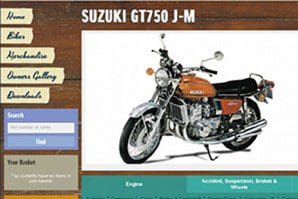

For all the innovations that have come and gone in motorcycle design over the years, only two manufacturers have ever mass produced a two-stroke triple and gone on to turn it into a sales success. Those two companies were, of course, Kawasaki and Suzuki, both of which saw the potential in such a design for a high performance, high tech motorcycle that would be relatively cheap to produce.
It's also rumoured in some circles that the two-stroke triple engine layout was already familiar to Japanese designers, having made an appearance in drones used for target practise by the Japanese navy in WWII.
Enjoy more Classic Motorcycle Mechanics reading in the monthly magazine.
Click here to subscribe & save.
Engine architecture
But, despite the similarities in basic engine architecture adopted by the two companies, Suzuki's distinctive design approach to their triples gave them a unique identity in the showroom. Offered in only three capacities – 380, 550 and 750, Suzuki opted to water cool the larger of the series and keep only the two middleweights dependant on air flow. The GT380 and GT550 were consequently quite similar in appearance, and both shared the novel ‘Ram Air System’ cooling cowling fitted over the cylinder head, a feature also seen on the GT250 and 185 twins. The GT550 also opted for a five-speed gearbox over its smaller sibling (the 380 had six speeds), reflecting the broader spread of both power and torque available from the 543cc engine.
Launched in 1972, the GT550J was originally fitted with a twin leading shoe front brake, soon dropped in favour of a single hydraulic disc adopted mid-season. Only colour schemes were changed for the 1973 GT550K model, and while the models progressed through L, M, A and B variants until the bikes demise in 1978, only relatively minor styling changes were ever made to the basic design. The L retained the bulbous side panels of the J and K, the M model receiving the sleeker, restyled panels common across the later GT series.
And it was a popular bike too, with a good balance of power and handling that made it fun to ride, and a little reflected glory from design elements shared by the bikes raced by Barry Sheene. At a final (1976) listed price of £795 the bike was affordable, and it delivered in the performance stakes with impressive acceleration (13 second standing quarters) and genuine ton-plus top speed.
 What let it down, and ultimately prevented any further development by Suzuki, was the death knell for two-strokes which was sounding loud and clear across the whole industry by the late 70s. For the GT550 and its ilk were both gas guzzlers and polluters to boot, and impending environmental legislation meant designers had to look to cleaner, more efficient four-strokes for the 80s.
What let it down, and ultimately prevented any further development by Suzuki, was the death knell for two-strokes which was sounding loud and clear across the whole industry by the late 70s. For the GT550 and its ilk were both gas guzzlers and polluters to boot, and impending environmental legislation meant designers had to look to cleaner, more efficient four-strokes for the 80s.
While it never quite tipped the scales of desirability like its big brother GT750 Kettle, the GT550 was a good, solid all rounder, and an impressive performer that fell within the financial reach of the average biker.
Owner
Ian Holmes is a serial restorer with a fondness for Suzuki two-strokes. His 1959 Colleda SB125 twin won the best in show trophy at last year’s Stafford Show. A VJMC member, Ian did all the restoration work on this GT550J himself, and has ridden and shown it regularly since its completion in 2000. ![]()
Advert
 Enjoy more Classic Motorcycle Mechanics reading in the monthly magazine. Click here to subscribe.
Enjoy more Classic Motorcycle Mechanics reading in the monthly magazine. Click here to subscribe.










